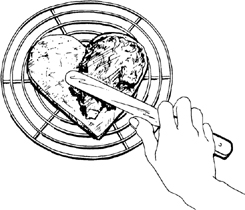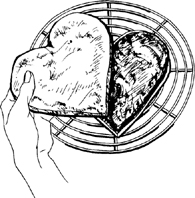Mastering the Art of French Cooking, Volume 2 (214 page)
Read Mastering the Art of French Cooking, Volume 2 Online
Authors: Julia Child

4)
Baking—about 40 minutes at 250 degrees
Set baking sheets on the upper-middle and lower-middle levels of preheated oven. The meringues are actually to dry out rather than bake; they will not puff up, and they will not change shape, but they will color lightly during baking. They are done as soon as you can gently push them loose from the baking surface, in 30 to 40 minutes. As soon as they are done, slip them carefully with a spatula onto cake racks to cool. They bend a little when still hot from the oven, but rapidly crisp as they cool; they are fragile and break easily, but a crack or break is not a disaster because the meringues are to be covered with frosting and filling.
5)
Butter cream for frosting and filling—crème au beurre à l’anglaise
1 cup sugar
A wire whip or hand-held electric beater
6 egg yolks
A heavy-bottomed enameled or stainless saucepan 2- to 2½-quart size
¾ cup hot milk
A wooden spoon
12 to 14 ounces (3 to 3½ sticks) chilled unsalted butter
1 tsp vanilla extract
3 Tb kirsch, dark rum, or strong coffee
Make a
crème anglaise
(custard sauce) as follows: gradually beat sugar into egg yolks and continue beating for several minutes until mixture is thick and pale yellow. In a thin stream of droplets beat in the hot milk, and set mixture over moderate heat. Stir slowly with wooden spoon, reaching all over bottom of pan, for 4 to 5 minutes or until sauce thickens enough to film spoon with a creamy layer—do not let it come to simmer, but you must heat it to the point where it thickens. Immediately remove from heat and beat vigorously for 1 minute to cool slightly.

If you wish to continue with an electric mixer on a stand, scrape the custard into the mixer bowl; otherwise proceed with hand-held electric beater (or with a wire whisk). Cut the 3 sticks of chilled butter into ¼-inch slices and add a piece or two at a time, beating vigorously as butter melts and is absorbed; when all the butter has gone in, cream should be cool, smooth, and glossy, like a thick mayonnaise. Beat in the vanilla and kirsch. (If mixture turns grainy, soften rest of butter by beating it or working with fingers, and beat in successive tablespoons until butter cream smooths out.)
for the frosting:
2 ounces unsweetened baking chocolate, melted
Remove ¼ of the butter cream to a small bowl, stir the smooth melted chocolate into it, and reserve for frosting top of cake, end of next step. Stir the
pralin
into the remaining butter cream; this will be the filling.
for the filling:
½ cup almond
pralin
(ground
caramelized almonds
)
Pralin
butter cream must have enough body to hold its shape as a filling; chill if necessary. Chocolate butter cream must be perfectly smooth and free of lumps when it covers top of cake: beat well, if necessary, before using.
6)
Assembling the cake
A tray or baking sheet to set cake rack on
A flexible-blade steel spatula
1 cup flaked, shaved, slivered, or chopped blanched almonds, toasted
One by one, place meringues on a cutting surface, set the marker you used in Step 1 on top, and trim meringues with a small, sharp knife. This is so that edges will line up properly when circumference of cake is iced. Return 1 meringue to cake rack set over tray.
Spread ⅓ of the pralin butter cream over the meringue on the cake rack |
|
| Center second meringue on top of first |



